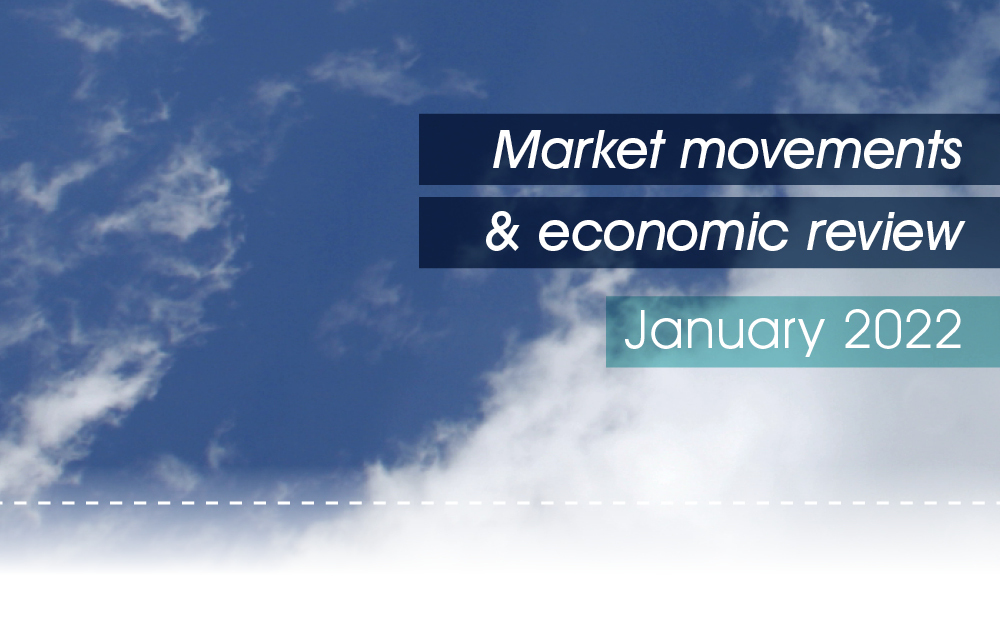Insights
January 2022

Content
- 2021 Year in Review
- Market movements & review video – January 2022
- Stepping stones to reach your goals
It’s January and the start of a new year. Whether you are back at work or enjoying a summer break, we wish you all a Happy New Year and a return to normal life in 2022.
The global economy and financial markets ended the year as they began, all over the place, as the world grappled with a new wave of COVID-19. In December, speculation about interest rate hikes grew on the back of rising inflation. US Federal Reserve chair, Jerome Powell said the Fed would not lift rates until it finished scaling back/tapering bond purchases in March. Fed officials expect three increases in the federal funds rate this year from the current 0-0.25% target to around 1.0%. In Australia, Reserve Bank governor Philip Lowe said he would not consider further scaling back bond purchases until the bank’s next meeting in February. He insists the cash rate will remain on hold at 0.1% until 2023, but the market anticipates a rate rise later this year.
Australia’s economic growth fell 3.9% in the year to September, as household spending fell during extended lockdowns. As lockdowns ended and businesses began hiring, the unemployment rate fell from 5.2% to 4.6% in November. The ANZ-Roy Morgan consumer sentiment index hit a six-week high of 108.4 in the lead up to Christmas. One cause for optimism may have been rising house prices, which were up 1% in December and 22% over the year.
Consumers also enjoyed some relief at the petrol bowser ahead of Christmas, but global oil prices remain volatile as markets weighs up reduced travel and falling demand for fuel due to Omicron and uncertain supply from OPEC producers. The Aussie dollar finished 2021 at US72.5c, a big drop from where it started at US77c.

2021 Year in Review
Two steps forward, one step back
For the second year running, the pandemic was the focus for policy makers, markets, businesses, and individuals alike.
The year began with hopes that the rollout of vaccines would stem the spread of COVID-19 and allow economies to reopen. Instead, most countries were hit by wave after wave of the virus, periodic lockdowns, and ongoing disruption to lives and livelihoods.
Yet there were also positives. Australia’s vaccination rate exceeded all expectations while property and share markets soared. Investors who stayed the course enjoyed double digit returns from their superannuation, with the median growth fund tipped to return more than 12 per cent for the year.i
The big picture
If the pandemic has taught us anything, it is to expect the unexpected as new variants of the coronavirus – first Delta and now Omicron – hampered plans to return to a ‘new normal’.
Yet through it all, the global economy picked up steam. In the year to September the two global powerhouses the US and China grew at an annual rate of 4.9 per cent, while the Australian economy grew by 3.9 per cent.
The Australian economy is estimated to have grown by more than 4 per cent in 2021, with unemployment falling to 4.6 per cent ahead of the Christmas rush.
But challenges remain. As global demand for goods and services picked up, ongoing shutdowns disrupted manufacturing and supply chains. The result was higher prices and emerging inflation.
Inflation and interest rates
Australia’s inflation rate jumped from less than one per cent to 3 per cent in 2021. This is lower than the US, where inflation hit 6.8 per cent, but it still led to speculation about interest rate hikes.
The Reserve Bank insists it won’t lift rates until inflation is sustainably between 2-3 per cent, unemployment is closer to 4 per cent and wages growth near 3 per cent. (Wages were up 2.2 per cent in the year to September.) The Reserve doesn’t expect to meet all these conditions until 2023 at the earliest, but many economists think it could be sooner.
While Australia’s cash rate remains at an historic low of 0.1 per cent, bond yields point to higher rates ahead. Australia’s 10-year government bond yields rose from 0.98 per cent to 1.67 per cent in 2021.
Shares continue to shine
Global sharemarkets made some big gains in 2021 on the back of economic recovery and strong corporate profits. The US market led the way, with the S&P500 index up 27 per cent to finish at near record highs.
European stocks also performed well while the Chinese market suffered from the government’s regulatory crackdown and the Evergrande property crisis.
In the middle of the pack, the Australian market rose a solid 13.5 per cent in 2021. The picture is even rosier when dividends are added, taking the total return to 17.7 per cent.ii
Volatile commodity prices
As the global economy geared up, so did demand for raw materials. Commodity prices were generally higher but with some wild swings along the way.
Oil prices rose around 53 per cent, thermal coal prices soared 111 per cent and coking coal rose 37 per cent. Australia’s biggest export, iron ore, fell 25 per cent but only after hitting a record high in May.
Despite demand for our raw materials and a sound economy, the Aussie dollar fell from US77c at the start of the year to finish at US72.5c, providing a welcome boost for Australian exporters.
Property boom
Australia’s residential property market had another bumper year, although the pace of growth shows signs of slowing. National home prices rose 22.1 per cent in 2021, according to CoreLogic. When rental income is included the total return from property was 25.7 per cent.iii
Regional areas (up 25.9 per cent) outpaced capital cities (up 21.0 per cent), as people fled to the perceived safety and affordability of the country during the pandemic. Even so, prices were up in all major cities.
Looking ahead
The pandemic is likely to continue to dominate economic developments in 2022. Much will depend on the supply and efficacy of vaccines to protect against Omicron and any future variants of the coronavirus.
Financial markets will also keenly watch for signs of inflation and rising interest rate. In Australia, inflation is unlikely to be constrained while wages growth remains low, and the Reserve Bank keeps rates on hold.
The wild card is the looming federal election which must be held by May. Until the outcome is known, uncertainty may weigh on markets, households, and business.
If you would like us to help you kick some goals in 2022, don’t hesitate to get in touch.
i https://www.chantwest.com.au/resources/remarkable-a-10th-consecutive-positive-year
Unless otherwise stated, figures were sourced from Trading Economics on 31/12/21

Market movements & review video – January 2022
Stay up to date with what’s happened in Australian markets over the past month.
The global economy and financial markets ended the year as they began, dominated by the pandemic, as the world grappled with a new wave of COVID-19.
Please get in touch if you’d like assistance with your personal financial situation.

Stepping stones to reach your goals
The calendar turns over to a fresh, brand new year, full of promise, so how do we keep these promises we make to ourselves and get to the end of the year with our resolutions intact and goals realised?
We all start out with good intentions when we set our objectives for the year to come, but motivation notoriously wanes with time and has the potential to sabotage our chances of achieving our dreams.
While many studies reinforce the notion that willpower struggles after only one month, a study tracking respondents over the course of a full year suggested that at around the three month mark half of resolutions fall over, increasing to a failure rate of around 82% by years end.i
Monthly micro goals
One way to deal with our waning motivation, instead of setting one daunting goal to be achieved over the period of a whole year, is to come up with a series of monthly, smaller goals. That will give you 12 ‘mini goals’ which ideally need to be achievable on a daily basis. The theory is that if you follow the same pattern for around 30 days, you’ll be establishing this pattern as a habit that you are likely to continue into the future. Each successive month will see you build on that success.
Working towards an end goal
Part of the key to making this approach work, is to ensure that all your monthly micro goals are working towards an overarching end goal. Your micro goals need to follow a theme.
This is where you can come back to your New Year’s resolution and base your theme on what you want to achieve for the year. Say your theme for the year is around career aspirations – for example achieving that promotion. Your first month could simply be setting aside some time each day to network and meet people within the organisation – improving your interpersonal skills. The next month might be focused on exploring tools to improve your productivity…and so on as you work your way through each successive month.
If your priority is to work on your health and wellbeing, and end the year capable of running ten kilometres, it’s also important to set some micro goals that get you there. Again, you can start small – a way of working incrementally towards your goal might be to start by drinking more water, then a month dedicated to getting more incidental exercise in your day, then a month focused on improving your diet and losing a little weight, working slowly up to lacing up your boots, hitting the track and increasing your endurance.
Smaller goals add up with time
We are calling them micro goals for a reason, it’s important to not bite off more than you can chew. The key is how they add up. Viewed alone these smaller goals may not seem like a lot, but the shorter duration makes it a lot more likely you’ll stick at them, developing good habits that will hopefully accrue, rather than fade over time. The fact that you are in effect starting afresh every month also gives you a much better chance of success.
Add some support into your plan
Don’t be afraid to put in some processes to help you get there – it can be a good idea to use online apps to aid or track your progress. It can also help to dangle the carrot and build in some rewards for when you get to the end of each month successfully. Tell friends and family what you are working on and celebrate your successes with them.
By the end of the year, you can look back with satisfaction at each little milestone as a personal win and you’ll have stepped towards, and finally reached an overall goal that may have seemed intimidating unless broken down into manageable chunks.
So what are you waiting for? Get out that calendar and pencil in a goal a month to reach your dreams this year.
i http://www.richardwiseman.com/quirkology/new/USA/Experiment_resolution.shtml
